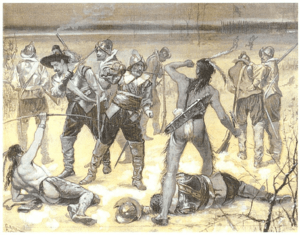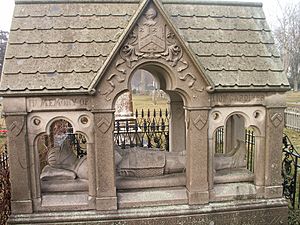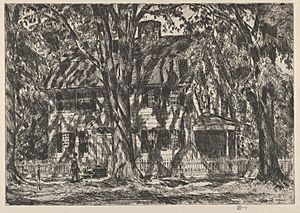Lion Gardiner facts for kids
Quick facts for kids
Lion Gardiner
|
|
|---|---|

Lion Gardiner (center, facing) in the Pequot War, by Charles Stanley Reinhart (painted circa 1890)
|
|
| Born | 1599 England
|
| Died | 1663 (aged 63–64) |
| Resting place | South End Cemetery by Town Pond |
| Occupation | military engineer, settler, soldier |
| Spouse(s) | Mary Willemsen Deurcant |
| Children |
|
| Signature | |
Lion Gardiner (born 1599, died 1663) was an English engineer and early settler. He is famous for starting the first English settlement in what is now New York State. He bought land on eastern Long Island, which became a very important place. Before coming to America, he worked in the Netherlands. He was hired to build strong forts along the Connecticut River for the Connecticut Colony. Today, Gardiners Island is named after him, and his family still owns it.
Contents
Lion Gardiner's Early Life
Lion Gardiner was born in England in 1599. He and his wife, Mary, left a town called Woerden in the Netherlands. They sailed to New England on a ship named Batcheler on July 10, 1635. Their ship arrived in Boston at the end of November that same year.
Governor John Winthrop wrote about Gardiner's arrival in his journal. He noted that a small ship arrived with "one Gardiner, an expert engineer." This ship also carried supplies to start a fort at the mouth of the Connecticut River. The journey was difficult, but everyone and all the goods arrived safely.
Gardiner's Career and Settlements
Gardiner was a military engineer who worked for the Prince of Orange in the Netherlands. He was hired by the Connecticut Company in 1635. His job was to build and manage forts in the Connecticut Colony. He finished and commanded the Saybrook Fort at the mouth of the Connecticut River. This was during the Pequot War of 1636–37, a conflict between English colonists and the Pequot tribe.
In 1639, Gardiner bought an island from the Montaukett tribe. They called it Manchonat. This island is located between the North and South forks of eastern Long Island. Today, it is part of Suffolk County, New York. When he bought the island, it became its own independent area. It was not part of the Connecticut Colony or New Amsterdam. Gardiner was even allowed to create laws for the island. He named it the Isle of Wight, but now it is known as Gardiners Island.
In 1660, Gardiner wrote a book about his experiences called Relation of the Pequot Warres. This book was lost for many years but was found again in 1809. It was first published in 1833.
Lion Gardiner's Family Life
Before leaving the Netherlands, Lion Gardiner married Mary Willemsen Deurcant. She was born around 1601 in Woerden. Mary passed away in 1665 in East Hampton, New York. They had three children together:
- David was born on April 29, 1636, in Saybrook. He married Mary Leringman in England in 1657.
- Mary was born on August 30, 1638, also in Saybrook, Connecticut. She married Jeremiah Conkling in 1658. Jeremiah was from Nottinghamshire, England.
- Elizabeth was born on September 14, 1641, on Gardiners Island, New York. She married Arthur Howell in 1657. Her death later led to a trial where someone was accused of witchcraft.

Lion Gardiner was buried in East Hampton, New York. A special tombstone with a statue of him lying down was built in 1886 to honor him.
Notable Descendants of Lion Gardiner
Lion Gardiner has thousands of descendants today. Some of his well-known family members include:
- Julia Gardiner Tyler, who became the second wife of President John Tyler. She was the First Lady of the United States from 1844 to 1845.
- Gardiner Greene Hubbard, a lawyer and businessman. He helped start the Bell Telephone Company and was the first president of the National Geographic Society.
- Mabel Gardiner Hubbard, who married Alexander Graham Bell. He is famous for inventing the first practical telephone.
- Gilbert Hovey Grosvenor, the first full-time editor and president of the National Geographic Society.
- Gilbert Melville Grosvenor, a past president and chief executive of the National Geographic Society.
- Melville Bell Grosvenor, who was president of the National Geographic Society and editor of National Geographic Magazine.
- Henry Cabot Lodge, Jr., a Republican Senator from Massachusetts. He was also a U.S. Ambassador to the United Nations and other countries.
- John Davis Lodge, an actor and Republican politician. He served as a U.S. Representative and governor of Connecticut.
- Roy Thomson, 1st Baron Thomson of Fleet, a Canadian businessman.
- Kenneth Thomson, 2nd Baron Thomson of Fleet, a Canadian billionaire and art collector.
- David Thomson, 3rd Baron Thomson of Fleet, a Canadian billionaire and art collector.
- Robert David Lion Gardiner, who was once an owner of Gardiners Island.
- Alexandra Creel Goelet, the current owner of Gardiners Island.


